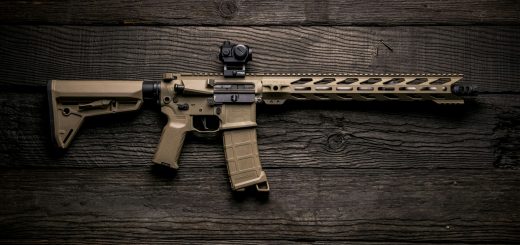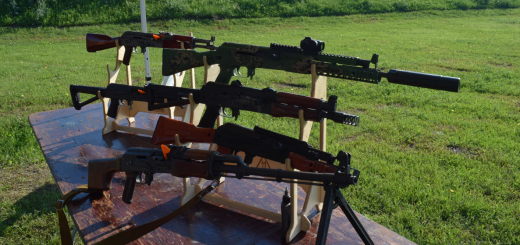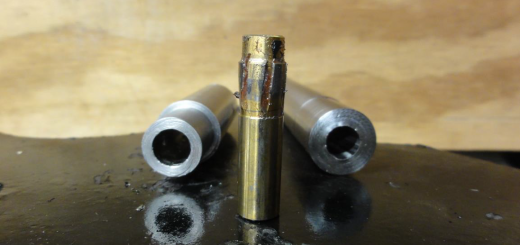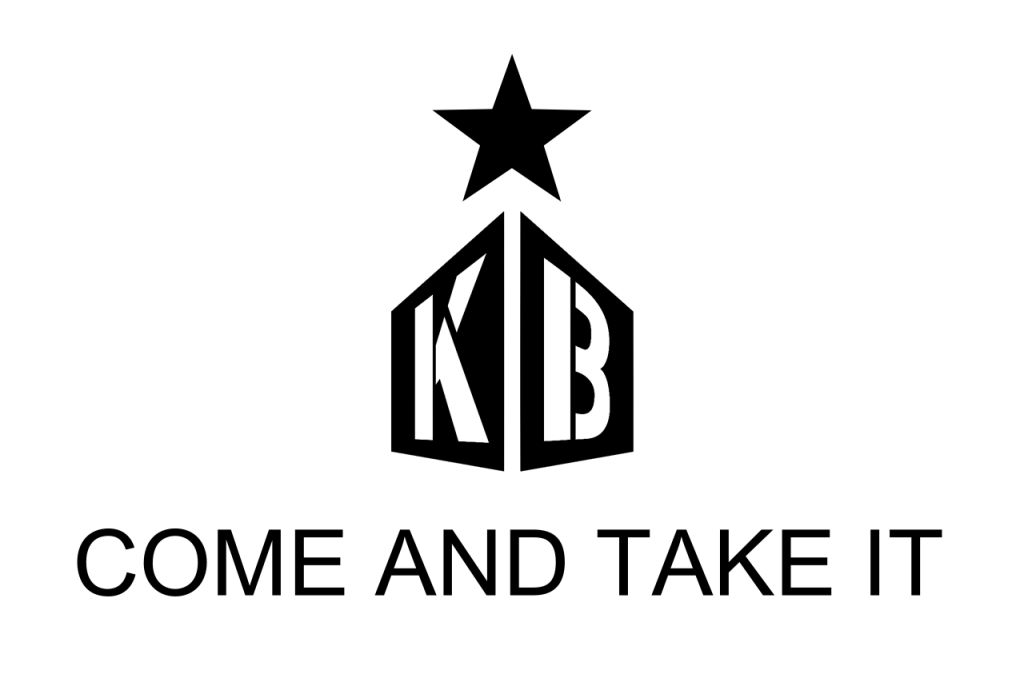Colt 723: The Gothic Serpent Carbine
The “Gordy” carbine made famous in Black Hawk Down
Few rifles capture the look and feel of early 1990s U.S. special operations quite like the Colt Model 723. Compact, rugged, and battle proven, the 723 served as a transitional point between the Vietnam era M16A1 and the later M4 carbines that would define the Global War on Terror. It was the rifle of choice for Delta Force operators during Operation Gothic Serpent in 1993, the mission in Mogadishu, Somalia, immortalized in Black Hawk Down. For many collectors and enthusiasts, the 723 represents a piece of living history from the last days of analog warfare.
At its core, the Colt 723 is a 14.5 inch carbine built on the M16A2 receiver and chambered in 5.56x45mm NATO with features that foreshadowed the coming M4. It used the A1 style fixed carry handle upper with the forward assist and case deflector bump, an early step toward the A2 receiver design. The barrel was thin and lightweight, often marked “C MP C,” and typically threaded for an A1 or A2 flash hider. This kept the rifle maneuverable and fast handling in tight urban spaces, which was exactly what Delta and the 75th Rangers needed in Somalia’s close quarters environment.
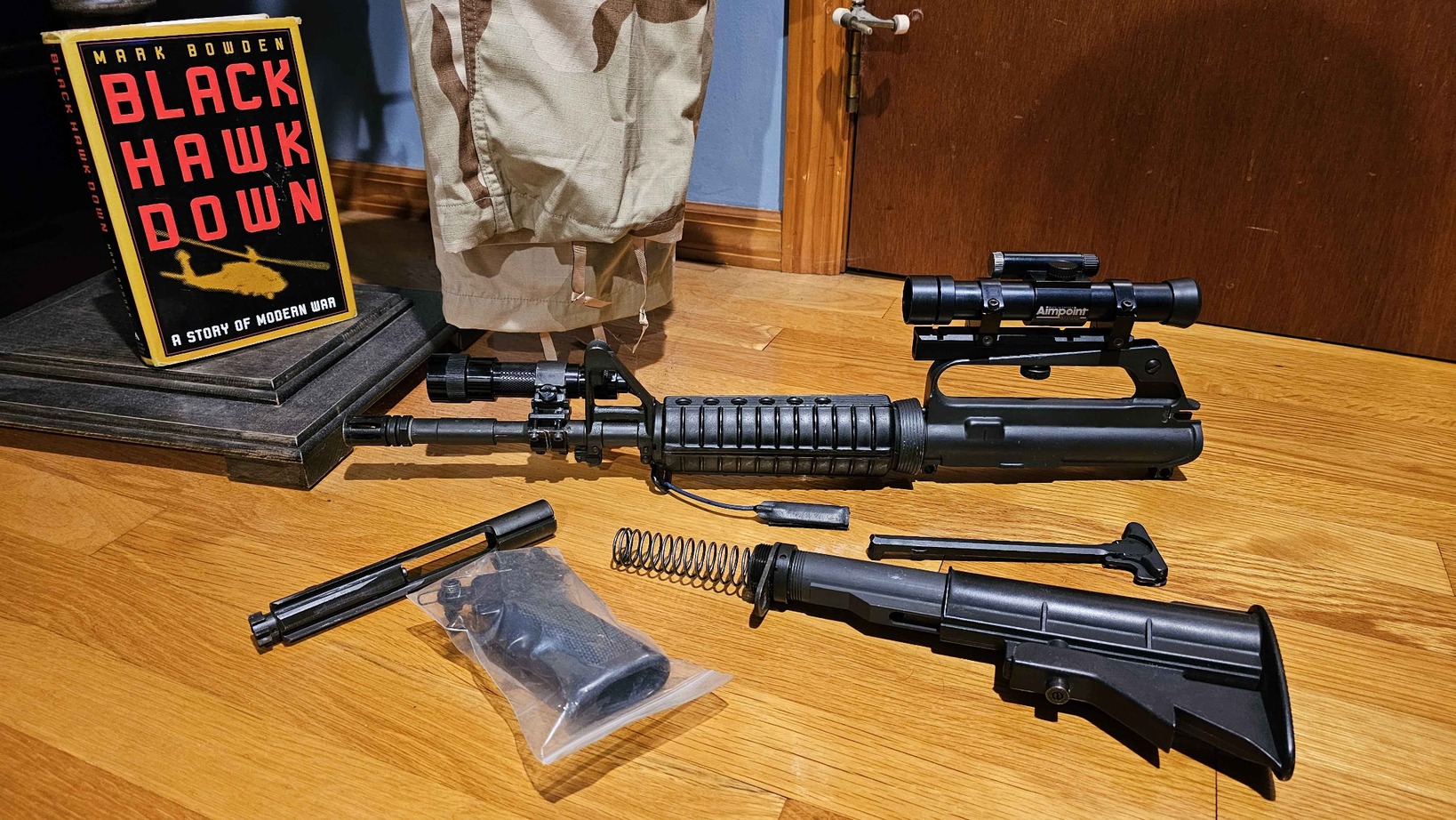
One of the most defining visuals of the 723 in Black Hawk Down is the pairing with the Aimpoint 3000 or 5000 optic mounted via a carry handle adapter. In the early 1990s this was cutting edge, a time when red dot sights were still relatively new and not yet standard issue. Operators like Gordon and Shughart famously carried these carbines, each customized slightly with accessories such as early SureFire weapon lights, tape switches, and two point nylon slings. These builds became the template for many modern clone projects, and their silhouette remains instantly recognizable to anyone familiar with special operations history.
From a collector’s standpoint, the 723 sits in an interesting middle ground. It isn’t quite an M4A1, but it isn’t an M16A1 either; it’s the bridge between two generations. Its design balances old school simplicity with modern adaptability, using the CAR 15 style collapsible stock, A1 rear sight, and carbine length gas system. Enthusiasts often build 723 clones using surplus Colt parts or retro inspired receivers and barrels to replicate the exact look used by Delta and Ranger units in 1993. The result is a carbine that feels lightweight and well balanced, ideal for both historical accuracy and range use.
The 723’s legacy goes beyond its role in Mogadishu. It influenced the design philosophy behind the later Colt 727 and M4, both of which carried forward its compact handling and modular capability. In many ways, the 723 proved the viability of a short, reliable carbine for front line use, something that wasn’t fully accepted until the early 2000s. Its operational success in the hands of Delta and the Rangers validated the concept of the carbine as a primary weapon rather than a compromise solution.
For modern builders and collectors, recreating a Colt 723 setup is both a technical challenge and a tribute. Finding the right parts such as a period correct AimPoint, SureFire light, and RediMag device takes effort, but the finished build captures an era when precision marksmanship met raw improvisation. It’s a rifle that tells a story, of soldiers in the streets of Mogadishu, of the birth of the modern carbine, and of a moment in time when skill and simplicity mattered more than rails and optics. For many enthusiasts, that’s exactly why the Colt 723 remains one of the most iconic carbines ever made.
Colt 723 parts list
| Part | Suggested Option | Notes |
|---|---|---|
| Upper receiver with fixed carry handle | A1 style carry handle upper, retro forged or quality reproduction (Like the C7 has). | Look for an upper that accepts a carry handle optic mount to match period correct builds |
| Barrel | 14.5 inch carbine length, government profile, 1 in 7 or 1 in 9 twist depending on ammo preference. | If you keep a 14.5 inch barrel, confirm legal requirements in your jurisdiction, many builders use a pinned and welded muzzle device or choose a 16 inch barrel for compliance |
| Front sight gas block | A1 fixed front sight gas block, gas tube included. | Period correct and rugged, aligns with original 723 geometry |
| Bolt carrier group | Milspec M16 or Colt pattern BCG. | Proper headspace and correct gas key staking are important for reliability |
| Charging handle | Standard M16 style charging handle. | Original 723 style uses the common M16 handle |
| Handguard | A1 round ribbed handguard or retro carbine handguard set. | Matches the look of early 1990s carbines, avoid modern free float tubes for authenticity |
| Stock and buffer assembly | CAR-15 style collapsible stock or period correct fiberlite carbine stock, standard carbine buffer and spring | Many 723s used a collapsible stock similar to CAR 15 variants |
| Lower receiver | Colt M16A2 marked. XM grey anodized preferable. | Use a trusted mil spec lower and properly fitted trigger group |
| Optic | Original Aimpoint 3000 or 5000, or Aimpoint Comp M2 style red dot if you’re going for the film version. | Aimpoint on a carry handle mount is iconic for the 723 look |
| Iron sights | A1 rear sight integrated on carry handle, A1 front sight post. | Keep original sight geometry for backup and period correct appearance |
| Sling and mounts | Two point nylon sling, metal sling swivels. | Simple web sling reflects the era and field setups |
| Light and accessories | Early SureFire 660 style weapon light with or without tape switch, simple tape switch routing. | Many operators used lights with basic mounts and trigger tape switches in the 1990s |
| Muzzle device | A1 or A2 style flash hider, pinned and welded if using 14.5 inch barrel. | Confirm legal options before finalizing muzzle device choice |
| Optional Extras | RediMag system, ideally an early manufacture version. | Clamps directly to the lower receiver and securely holds a second, fully loaded magazine. |
